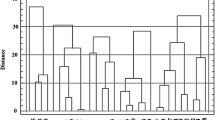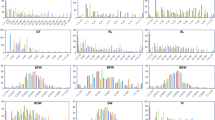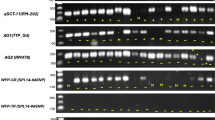Abstract
Brassica napus (Brassicaceae) is among the most important oil crops and a promising biofuel. In the tropics and subtropics, boron (B) deficiency is a major factor limiting Brassica yields. The effect of B on the regulation of root and shoot growth in a doubled haploid (DH) population was evaluated in experiments that utilized hydroponic culture. Strong genetic variability for traits of interest at normal and low B concentrations was demonstrated. Quantitative trait loci (QTL) were analyzed for seven plant growth parameters: increment of primary root length (IPRL), shoot dry weight (SDW), root dry weight (RDW), ratio of RDW to SDW (R/S), shoot B accumulation (SBA), root B accumulation (RBA), and ratio of RBA to SBA [(R/S)BA] in the population. Twenty-seven QTL were detected at normal B levels: four for IPRL, seven for SDW, three for RDW, two for R/S, six for SBA, two for RBA, and three for (R/S)BA. At low B, 18 QTL were detected: four for IPRL, three for SDW, two for RDW, two for R/S, five for SBA, one for RBA, and one for (R/S)BA. Three QTL for adaptability were detected: one A_IPRL and two A_SDW. No putative QTL was detected at both low and normal B. B-related genes were mapped in silico and their locations compared with the QTL identified. The present analyses show the profound and varied effects of B on B. napus and studies on QTL related to B efficiency will help to locate candidate genes and elucidate possible functions of B-efficiency-related QTL.

Similar content being viewed by others
References
Brown PH, Bellaloui N, Hu HN, Dandekar AM (1999) Transgenically enhanced sorbitol synthesis facilitates phloem boron transport and increases tolerance of tobacco to boron deficiency. Plant Physiol 119:17–20
Cao XY, Liu WD, Pi MM (1997) The research on B absorption characteristics of two rape genotypes responding differently to B deficiency. J Huazhong Agric Univ 16:336–339 (in Chinese with English abstract)
Churchill GA, Doerge RW (1994) Empirical threshold values for quantitative trait mapping. Genetics 138:963–971
Graham RD (1984) Breeding for nutritional characteristics in cereals. Adv Plant Nutr 1:57–102
Hoagland DR, Arnon DI (1950) The water-culture method for growing plants without soil. Calif AES Bull 347:1–32
Hu QH, Xu GB, Shi RH (1990) Study on the inheritable difference on boron nutrition of different cultivars of oilseed rape. J Nanjing Agric Univ 13:80–86 (in Chinese with English abstract)
Ishii T, Matsunaga T (1996) Isolation and characterization of a boron-rhamnogalacturonan-II complex from cell walls of sugar beet pulp. Carbohydr Res 284:1–9
Iwai H, Hokura A, Oishi M, Chida H, Ishii T, Sakai S, Satoh S (2006) The gene responsible for borate cross-linking of pectin rhamnogalacturonan-II is required for plant reproductive tissue development and fertilization. Proc Natl Acad Sci USA 103:16592–16597
Kobayashi M, Matoh T, Azuma J (1996) Two chains of rhamnogalacturonan II are cross-linked by borate-diol ester bonds in higher plant cell walls. Plant Physiol 110:1017–1020
Kobayashi M, Mutoh T, Matoh T (2004) Boron nutrition of cultured tobacco BY-2 cells. IV. Genes induced under low boron supply. J Exp Bot 55:1441–1443
Koshiba T, Kobayashi M, Matoh T (2009) Boron nutrition of tobacco BY-2 cells. V. Oxidative damage is the major cause of cell death induced by boron deprivation. Plant Cell Physiol 50:26–36
Liu Z, Zhu QQ, Tong LH (1989) Regularities of content and distribution of boron in soils. Acta Pedol Sin 26:353–361 (in Chinese with English abstract)
Long Y, Shi J, Qiu D, Li R, Zhang C, Wang J, Hou J, Zhao J, Shi L, Lim YP, Choi SR, Park BS, Meng J (2007) Flowering time quantitative trait loci analysis of oilseed Brassica in multiple environments and genomewide alignment with Arabidopsis. Genetics 177:2433–2444
Lukowitz W, Gillmor CS, Scheible WR (2000) Positional cloning in Arabidopsis. Why it feels good to have a genome initiative working for you. Plant Physiol 123:795–805
Marschner H (1995) Mineral nutrition of higher plants (2nd ed.). Academic Press, London
Miwa K, Takano J, Omori H, Seki M, Shinozaki K, Fujiwara T (2007) Plants tolerant of high boron levels. Science 318:1417
O’Neill MA, Warrenfeltz D, Kates K, Pellerin P, Doco T, Darvil AG, Albersheim P (1996) Rhamnogalacturonan-II, a pectic polysaccharide in the walls of growing plant cell, forms a dimer that is covalently cross-linked by a borate ester–In vitro conditions for the formation and hydrolysis of the dimmer. J Biol Chem 271:22923–22930
O’Neill MA, Eberhard S, Albersheim P, Darvill AG (2001) Requirement of borate cross-linking of cell wall rhamnogalacturonan II for Arabidopsis growth. Science 294:846–849
O’Neill MA, Ishii T, Albersheim P, Darvill AG (2004) Rhamnogalacturonan II: structure and function of a borate cross-linked cell wall pectic polysaccharide. Annu Rev Plant Biol 55:109–139
Parkin IAP, Gulden SM, Sharpe AG, Lukens L, Trick M, Osborn TC, Lydiate DJ (2005) Segmental structure of the Brassica napus genome based on comparative analysis with Arabidopsis thaliana. Genetics 171:765–781
Qiu D, Morgan C, Shi J, Long Y, Liu J, Li R, Zhuang X, Wang Y, Tan X, Dietrich E, Weihmann T, Everett C, Vanstraelen S, Beckett P, Fraser F, Trick M, Barnes S, Wilmer J, Schmidt R, Li J, Li D, Meng J, Bancroft I (2006) A comparative linkage map of oilseed rape and its use for QTL analysis of seed oil and erucic acid content. Theor Appl Genet 114:67–80
Schmidt R, Acarkan A, Boivin K (2001) Comparative structural genomics in the Brassicaceae family. Plant Physiol Biochem 39:253–262
Shi L, Nian FZ, Zhao H, Xu FS, Meng JL, Wang YH (2004) Responses to boron deficiency in 7 varieties of rape (Brassica napus L.). Chin J Oil Crop Sci 26:50–53 (in Chinese with English abstract)
Shorrocks VM (1997) The occurrence and correction of boron deficiency. Plant Soil 193:121–148
Stangoulis JCR, Grewal HS, Bell RW, Graham RD (2000a) Boron efficiency in oilseed rape: I. Genotypic variation demonstrated in field and pot grown Brassica napus L. and Brassica juncea L. Plant Soil 225:243–251
Stangoulis JCR, Webb MJ, Graham RD (2000b) Boron efficiency in oilseed rape: II. Development of a rapid lab-based screening technique. Plant Soil 225:253–261
Sun J, Shi L, Zhang C, Xu F (2011) Cloning and characterization of boron transporters in Brassica napus. Mol Biol Rep. doi:10.1007/s11033-011-0930-z
Sutton T, Baumann U, Hayes J, Collins N, Shi B, Schnurbusch T, Hay A, Mayo G, Pallotta M, Tester M, Langridge P (2007) Boron-toxicity tolerance in barley arising from efflux transporter amplification. Science 318:1446–1449
Takano J, Noguchi K, Yasumori M, Kobayashi M, Gajdos Z, Miwa K, Hayashi H, Yoneyama T, Fujiwara T (2002) Arabidopsis boron transporter for xylem loading. Nature 420:337–340
Takano J, Wada M, Ludewig U, Schaaf G, Wirén N, Fujiwara T (2006) The Arabidopsis major intrinsic protein NIP5;1 is essential for efficient boron uptake and plant development under boron limitation. Plant Cell 18:1498–1509
Wang YH, Lan LF (1995) A study on boron efficiency of rape (Brassica napus). J Huazhong Agric Univ Sup 21:92–97 (in Chinese with English abstract)
Wang LX, Jianwei Zhao, Xu FS, Liu RH, Meng JL (2002) Integration of DNA clones related to important economic traits of Brassica napus onto Arabidopsis genetic map. Acta Genet Sin 29:741–746 (in Chinese with English abstract)
Wang SC, Bastern J, Zeng ZB (2006) Windows QTL cartographer 2.5. Department of statistics, North Carolina state university, Raleigh, NC. http://statgen.ncsu.edu/qtlcart/WQTLCart.htm
Wang ZF, Wang ZH, Shi L, Wang LJ, Xu FS (2010) Proteomic alterations of Brassica napus root in response to boron deficiency. Plant Mol Biol 74:265–278
Wang ZH, Wang ZF, Chen SS, Shi L, Xu FS (2011) Proteomics reveals the adaptability mechanism of Brassica napus to short-term boron deprivation. Plant Soil 347:195–210
Warington K (1923) The effect of boric acid and borax on the broad bean and certain other plants. Ann Bot (Lond) 37:629–672
Xu FS, Wang YH, Meng JL (2001) Mapping boron efficiency gene(s) in Brassica napus using RFLP and AFLP markers. Plant Breed 20:319–324
Xu FS, Wang YH, Ying WH, Meng JL (2002) Inheritance of boron nutrition efficiency in Brassica napus. J Plant Nutr 25:901–912
Xue JM, Lin MS, Bell RW, Graham RD, Yang XE, Yang YA (1998) Differential response of oilseed rape (Brassica napus L.) cultivars to low boron supply. Plant Soil 204:155–163
Yang YA, Xue JM, Ye ZQ, Wang K (1993) Responses of rape genotypes to boron application. Plant Soil 156:321–324
Yang TJ, Kim JS, Kwon SJ, Lim KB, Choi BS, Kim JA, Jin M, Park JY, Lim MH, Kim HI, Lim YP, Kang JJ, Hong JH, Kim CB, Bhak J, Bancroft I, Park BS (2006) Sequence-level analysis of the diploidization process in the triplicated FLOWERING LOCUS C region of Brassica rapa. Plant Cell 18:1339–1347
Zeng C, Han Y, Shi L, Peng L, Wang Y, Xu F, Meng J (2008) Genetic analysis of the physiological responses to low boron stress in Arabidopsis thaliana. Plant Cell Environ 31:112–122
Zhao H, Shi L, Duan XL, Xu FS, Wang YH, Meng JL (2008) Mapping and validation of chromosome regions conferring a new boron-efficient locus in Brassica napus. Mol Breed 22:495–506
Acknowledgments
We greatly acknowledge the efforts of Gautam Mayank and Genedits (Genedits: www.genedits.com) in reading and editing the English version of the manuscript. This work was supported by grants from the National Basic Research Program of China (973 program) (2011CB109302), National Natural Science Foundation of China (31172018) and the Fundamental Research Funds for the Central Universities (2011PY150).
Author information
Authors and Affiliations
Corresponding author
Rights and permissions
About this article
Cite this article
Shi, L., Yang, J., Liu, J. et al. Identification of quantitative trait loci associated with low boron stress that regulate root and shoot growth in Brassica napus seedlings. Mol Breeding 30, 393–406 (2012). https://doi.org/10.1007/s11032-011-9629-z
Received:
Accepted:
Published:
Issue Date:
DOI: https://doi.org/10.1007/s11032-011-9629-z




